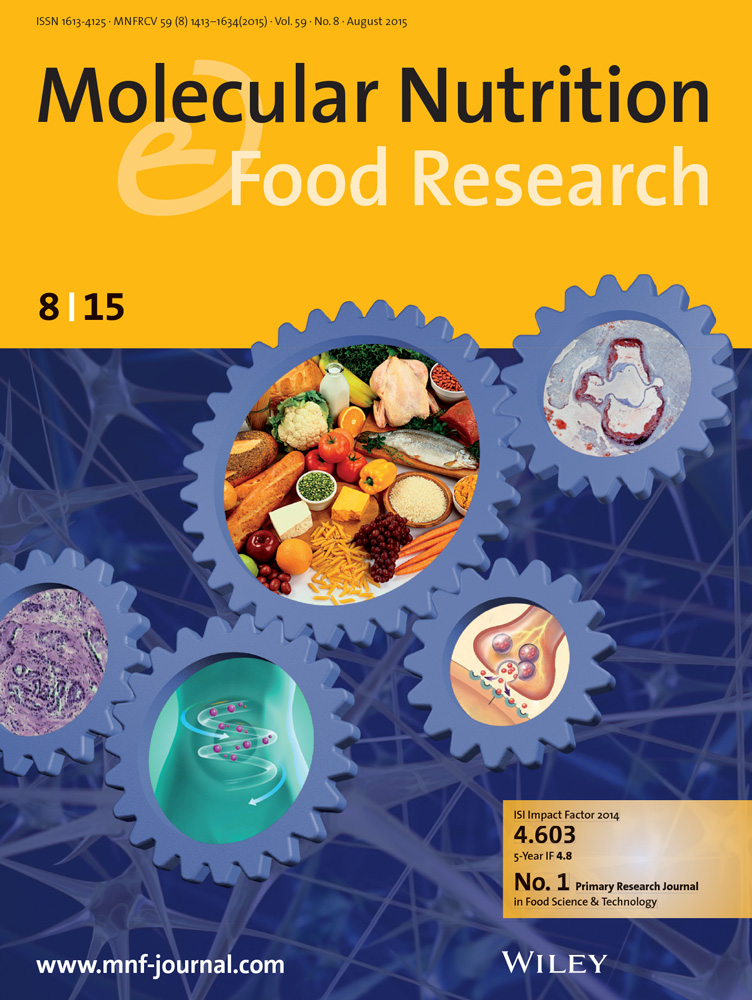保护人体脂肪细胞免受炎症:富含多酚的无花果树提取物的保护潜力。
IF 4.5
2区 农林科学
Q1 FOOD SCIENCE & TECHNOLOGY
引用次数: 0
摘要
无花果树(Opuntia ficus-indica, OFI)作为一种抗氧化和抗炎化合物的来源而受到广泛关注。我们推测,OFI提取物的抗氧化成分可能改善肥厚性脂肪细胞炎症刺激引起的脂肪细胞功能障碍。为此,我们从抗氧化活性、调节脂肪细胞炎症和脂肪细胞/单核细胞相互作用等方面评估了OFI枝醇提取物的特性,这些脂肪细胞因促炎细胞因子肿瘤坏死因子-α (TNF-α)而功能失调。鉴定出的主要酚类化合物为异鼠李素衍生物和酚酸,包括鱼酸和真豆酸。我们的研究结果表明,OFI cladode提取物具有抗自由基活性,并通过抑制各种细胞因子、趋化因子和粘附分子,如白细胞介素(IL)-6和IL-8约80%,单核细胞趋化蛋白(MCP)-1, C-X-C motif趋化因子配体(CXC-L)10,巨噬细胞集落刺激因子(M-CSF)从40%到50%,以及细胞间粘附分子-1 (ICAM-1)在较高浓度下降低70%,降低单核细胞对炎症脂肪细胞的粘附和转运活性。在蛋白配体对接分析的结构和机制研究中,鱼酸被证明是与核因子红系2相关因子2 (NRF-2)和核因子-κB (NF-κB)活性调控相互作用的最佳潜在候选者。总之,这些数据强调了OFI作为一种膳食补充剂在营养治疗中对抗肥胖炎症的潜力。本文章由计算机程序翻译,如有差异,请以英文原文为准。
Shielding Human Adipocytes From Inflammation: The Protective Potential of Polyphenol-Rich Opuntia ficus-indica Cladode Extract.
Opuntia ficus-indica (OFI) has attracted much attention as a source of antioxidant and antiinflammatory compounds. We hypothesize that the antioxidant content of OFI cladode extract may improve adipocyte dysfunction resulting from inflammatory stimulation of hypertrophic adipocytes. To this end, the properties of OFI cladode hydroalcoholic extract were evaluated in terms of antioxidant activity, regulation of adipocyte inflammation, and adipocyte/monocyte interaction in human adipocytes rendered dysfunctional by the proinflammatory cytokine tumor necrosis factor-α (TNF-α). The major phenolic compounds identified were isorhamnetin derivatives and phenolic acids, including piscidic and eucomic acids. Our results show that OFI cladode extract exhibits antiradical activities and reduces the adhesion and transmigration activity of monocytes to inflamed adipocytes by inhibiting various cytokines, chemokines, and adhesion molecules such as interleukin (IL)-6 and IL-8 by ∼80%, monocyte chemotactic protein (MCP)-1, C-X-C motif chemokine ligand (CXC-L)10, macrophage colony-stimulating factor (M-CSF) from 40% to 50%, and intercellular adhesion molecule-1 (ICAM-1) by 70% at the higher concentration. In structurally and mechanistically by protein-ligand docking profiling study, piscidic acid proved to be the best potential candidate for a regulatory interaction with the activities of nuclear factor erythroid 2-related factor 2 (NRF-2) and nuclear factor-κB (NF-κB). In summary, these data highlight the potential of OFI as a dietary supplement in nutritional treatments aimed at combating the inflammatory stigmata of obesity.
求助全文
通过发布文献求助,成功后即可免费获取论文全文。
去求助
来源期刊

Molecular Nutrition & Food Research
工程技术-食品科技
CiteScore
8.70
自引率
1.90%
发文量
250
审稿时长
1.7 months
期刊介绍:
Molecular Nutrition & Food Research is a primary research journal devoted to health, safety and all aspects of molecular nutrition such as nutritional biochemistry, nutrigenomics and metabolomics aiming to link the information arising from related disciplines:
Bioactivity: Nutritional and medical effects of food constituents including bioavailability and kinetics.
Immunology: Understanding the interactions of food and the immune system.
Microbiology: Food spoilage, food pathogens, chemical and physical approaches of fermented foods and novel microbial processes.
Chemistry: Isolation and analysis of bioactive food ingredients while considering environmental aspects.
 求助内容:
求助内容: 应助结果提醒方式:
应助结果提醒方式:


